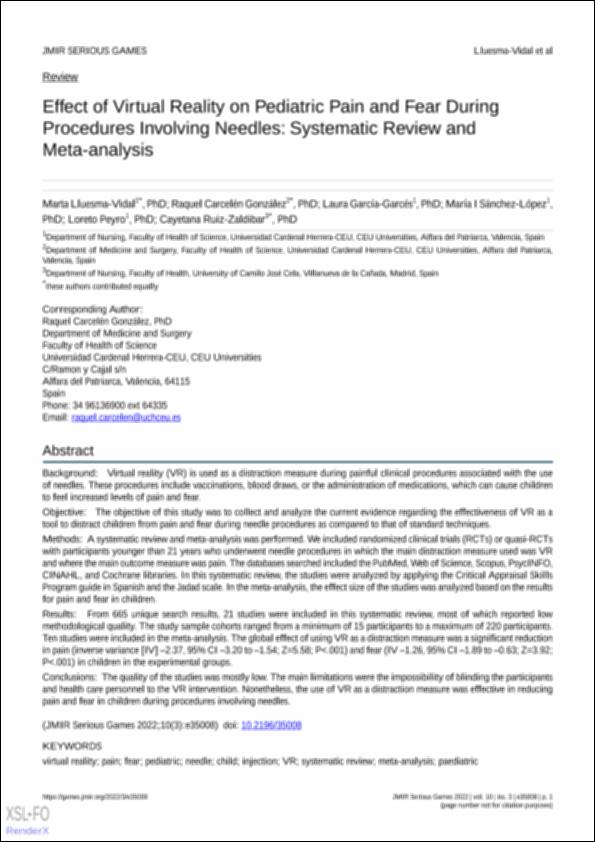Please use this identifier to cite or link to this item:
http://hdl.handle.net/10637/14216Effect of virtual reality on pediatric pain and fear during procedures involving needles systematic review and meta-analysis
| Title: | Effect of virtual reality on pediatric pain and fear during procedures involving needles systematic review and meta-analysis |
| Authors : | Lluesma Vidal, Marta Carcelén González, Raquel García Garcés, Laura Sánchez López, María Inmaculada Peyró Gregori, María Loreto Ruiz Zaldibar, Cayetana |
| Keywords: | Fear in children.; Realidad virtual - Aplicaciones en pediatría.; Virtual reality in pediatrics.; Miedos infantiles. |
| Publisher: | JMIR |
| Citation: | Lluesma-Vidal, M., Carcelén González, R., García-Garcés, L., Sánchez-López, M. I., Peyro, L. & Ruiz-Zaldibar, C. (2022). Effect of virtual reality on pediatric pain and fear during procedures involving needles: systematic review and meta-analysis. JMIR Serious Games, vol. 10, i. 3 (09 aug.), art. e35008. DOI: https://doi.org/10.2196/35008 |
| Abstract: | Background: Virtual reality (VR) is used as a distraction measure during painful clinical procedures associated with the use of needles. These procedures include vaccinations, blood draws, or the administration of medications, which can cause children to feel increased levels of pain and fear. Objective: The objective of this study was to collect and analyze the current evidence regarding the effectiveness of VR as a tool to distract children from pain and fear during needle procedures as compared to that of standard techniques. Methods: A systematic review and meta-analysis was performed. We included randomized clinical trials (RCTs) or quasi-RCTs with participants younger than 21 years who underwent needle procedures in which the main distraction measure used was VR and where the main outcome measure was pain. The databases searched included the PubMed, Web of Science, Scopus, PsycINFO, CINAHL, and Cochrane libraries. In this systematic review, the studies were analyzed by applying the Critical Appraisal Skills Program guide in Spanish and the Jadad scale. In the meta-analysis, the effect size of the studies was analyzed based on the results for pain and fear in children. Results: From 665 unique search results, 21 studies were included in this systematic review, most of which reported low methodological quality. The study sample cohorts ranged from a minimum of 15 participants to a maximum of 220 participants. Ten studies were included in the meta-analysis. The global effect of using VR as a distraction measure was a significant reduction in pain (inverse variance [IV] –2.37, 95% CI –3.20 to –1.54; Z=5.58; P<.001) and fear (IV –1.26, 95% CI –1.89 to –0.63; Z=3.92; P<.001) in children in the experimental groups. Conclusions: The quality of the studies was mostly low. The main limitations were the impossibility of blinding the participants and health care personnel to the VR intervention. Nonetheless, the use of VR as a distraction measure was effective in reducing pain and fear in children during procedures involving needles. |
| Description: | Este artículo se encuentra disponible en la siguiente URL: https://games.jmir.org/2022/3/e35008/ |
| URI: | http://hdl.handle.net/10637/14216 |
| Rights : | http://creativecommons.org/licenses/by/4.0/deed.es |
| ISSN: | 2291-9279 (Electrónico) |
| Language: | es |
| Issue Date: | 9-Aug-2022 |
| Center : | Universidad Cardenal Herrera-CEU |
| Appears in Collections: | Dpto. Medicina y Cirugía |
Items in DSpace are protected by copyright, with all rights reserved, unless otherwise indicated.


